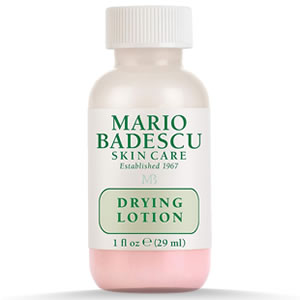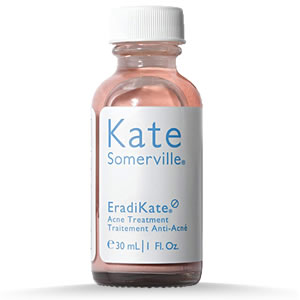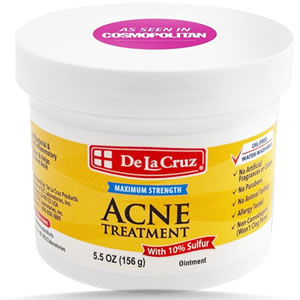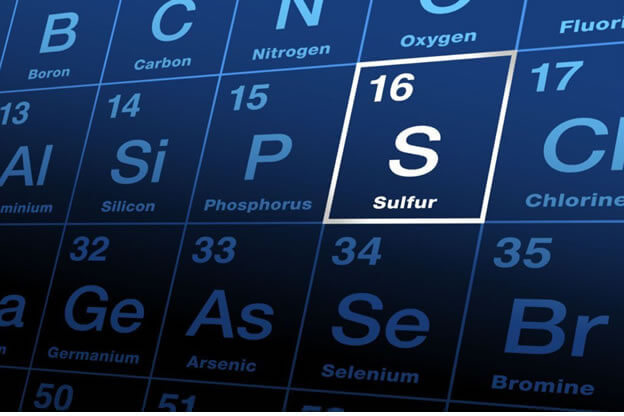
Acne is a common skin condition that affects millions of people worldwide. While most people are familiar with traditional acne, caused by excess oil and acne bacteria, there is another type of acne that is often misunderstood: fungal acne.
Fungal acne, also known as Malassezia folliculitis, is caused by an overgrowth of yeast on the skin, leading to small, itchy bumps that resemble acne.
One powerful ingredient that has gained attention for its effectiveness in treating fungal acne is sulfur.
In this article, we will explore the advantages of using sulfur to treat fungal acne and provide some practical treatment tips for managing this troublesome skin condition.
What Is Fungal Acne?
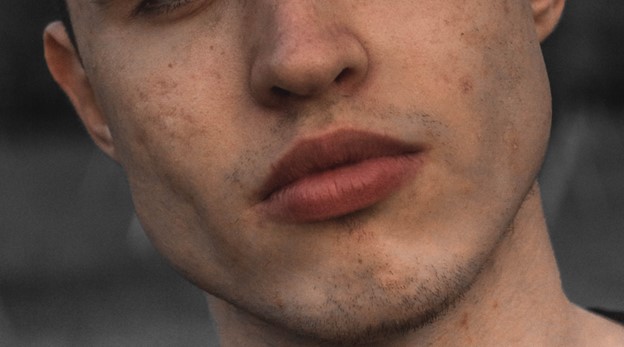
As stated, fungal acne results from an overgrowth of yeast called Malassezia on the skin. This yeast is naturally present on the skin, but when it multiplies excessively, it can develop small, red bumps that resemble acne.
Unlike bacterial acne, fungal acne is not caused by bacteria or excess oil production. Instead, it can be triggered by humidity, excess sweating, non-breathable clothing, immune disorders, and occlusive skincare products. [1]
The Power Of Sulfur
Sulfur has been used for centuries to treat various skin conditions, including acne.
It is a naturally occurring mineral that has potent antimicrobial and anti-inflammatory properties. These properties make sulfur a practical option for combating fungal acne.
Sulfur as an Effective Treatment for Fungal Acne
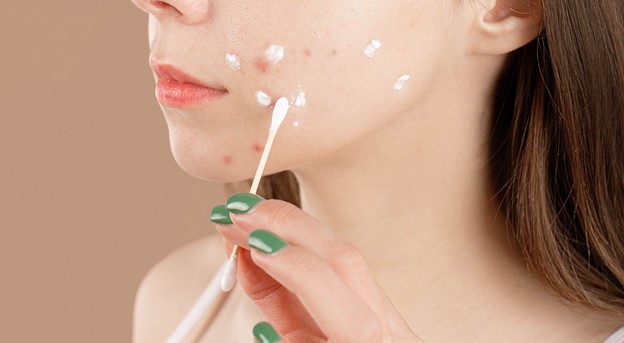
1. Antifungal Properties Of Sulfur
One of the standout benefits of sulfur acne treatment lies in its antifungal properties.
When sulfur is applied to the skin, it produces pentathionic acid, which is deadly to fungi such as Malassezia, the yeast responsible for causing fungal acne.
By actively inhibiting the growth of this yeast, sulfur helps to tackle the condition’s root cause and may directly impede the development of Malassezia. [4]
Additionally, it reduces inflammation and irritation commonly associated with fungal acne, providing relief and promoting healing. [2 , 3 ]
2. Antibacterial Properties Of Sulfur
Although fungal acne is primarily caused by yeast, sulfur’s antibacterial properties can still be advantageous. It safeguards against secondary bacterial infections from scratching and irritation caused by fungal acne.
By preventing the proliferation and infection of bacteria, sulfur aids in maintaining a healthy skin environment, allowing the skin to recover more efficiently. [5 , 6 ]
3. Anti-Inflammatory Effects Of Sulfur
Fungal acne can cause redness, swelling, and discomfort on the skin. Fortunately, sulfur possesses remarkable anti-inflammatory effects, which can play a crucial role in soothing the skin and alleviating these symptoms. [12]
By calming the skin, sulfur can provide immediate relief for not only Malassezia folliculitis but also other types of acne-related skin concerns, such as rosacea, seborrheic dermatitis, bacterial acne, and closed comedones.
Furthermore, sulfur has the ability to speed up the healing process and lower the chance of scarring.
4. Exfoliating Action Of Sulfur
Another advantage of sulfur for fungal acne treatment is its exfoliating properties.
By effectively removing dead skin cells and unclogging pores, sulfur prevents the accumulation of oil and debris that can contribute to developing fungal acne.
This exfoliating action promotes healthy cell turnover, rejuvenating the skin and enhancing its overall texture and appearance. [7]
5. Sebum Regulation
One notable advantage of sulfur in addressing fungal acne is its ability to regulate sebum production.
Excessive sebum production can result in oily skin, which can create an environment that encourages the growth of fungi and bacteria. This ongoing oiliness can eventually cause fungal acne to develop. [8 , 9]
By balancing sebum levels, sulfur helps to reduce the availability of nutrients (fatty acids) that support the growth of the yeast, ultimately hindering its ability to thrive and cause acne breakouts. [13]
6. Minimal Resistance Development
In acne treatments, the concern of resistance development is always present. However, sulfur is a favorable option due to its minimal tendency to promote resistance.
Unlike some topical medications and antibiotics, sulfur is less likely to lead to the development of microbial resistance, ensuring its continued effectiveness in treating fungal acne over the long term.
These TOP Sulfur-Based Products are Game-Changers. Plus, they’re Completely safe for Fungal Acne
Mario Badescu Drying Lotion (10% Sulfur)
Mario Badescu Drying Lotion is considered one of the best sulfur-based products to use for treating fungal acne. This product has received high praise for its ability to treat breakouts effectively.
A major benefit of using this product is that it contains a powerful combination of sulfur, anti-inflammatory agents, and other acne-fighting ingredients like salicylic acid.
This makes it an effective solution for both bacterial and fungal breakouts.
ProTip:
When paired with their drying lotion, their innovative drying patches offer a speedy and efficient solution for combating and clearing up acne fast.
Kate Somerville EradiKate (10% Sulfur)
The Kate Somerville EradiKate Acne Treatment is another well-known option for treating fungal acne.
Its fast-acting formula effectively reduces bacterial and fungal pimples while also alleviating redness and inflammation.
This product stands out because it includes both sulfur and zinc oxide, which work in tandem to combat inflammation and eliminate acne-causing bacteria, leading to visibly clearer skin.
De La Cruz Acne Treatment (10% Sulfur)
Another effective acne treatment to consider is De La Cruz Acne Treatment Maximum Strength with 10% Sulfur.
This product contains a powerful concentration of sulfur that can help combat bacteria and fungi, as well as reduce inflammation.
By targeting and eliminating the underlying yeast and bacterial infections, this treatment can help address most forms of acne.
For individuals struggling with fungal skin concerns like rosacea, seborrheic dermatitis, tinea versicolor, and fungal acne Joesoef Skin Care’s Sulfur Soap with 10% Volcanic Sulfur is a highly recommended solution. This trustworthy product has been in the market for years and has been proven to be effective.
Powered by a pH-balanced formula, this sulfur soap for fungal acne can help clear up blemishes quickly on both the face and body.
This medicated bar soap can be particularly useful for those with oily skin, body acne, blackheads, whiteheads, and other skin-related blemishes. Developed by dermatologists, it contains 0.25% salicylic acid that can gently exfoliate while reducing inflammation and yeast overgrowth associated with fungal acne.
However, if you have active fungal acne breakouts, this may not be the best option for you. Instead, it can serve as a great maintenance sulfur soap for fungal acne once you’ve cleared up your fungal acne.
The reason for this is that there are some ingredients in the product that could potentially trigger fungal acne, such as Saponified Palm Oil, Saponified Palm Kernel Oil, Lanolin, and Coconut Fatty Acids. Our recommendation is to steer clear of all triggers until your skin is entirely free from any fungal acne to prevent aggravating the condition.
Drawbacks Of Sulfur
While sulfur can be highly effective in treating fungal acne, it is essential to note some potential drawbacks.
- Sulfur has a distinct smell, often described as rotten eggs, which can be off-putting to some individuals.
- Also, sulfur can cause dryness and irritation, particularly for dehydrated and sensitive skin types.
In order to reduce these negative effects, it’s crucial to use sulfur products in moderation and follow a gentle skincare routine.
Practical Treatment Tips for Fungal Acne
#1 Choosing Sulfur-based Products
When selecting sulfur-based products for fungal acne, opting for those specifically formulated for this condition is essential. Look for fungal acne safe products with high sulfur concentrations and other soothing ingredients, like aloe vera or chamomile. These can help to counteract any potential dryness or irritation caused by sulfur.
#2 Patch Testing for Sensitivity
Before applying any sulfur-based product to your face, it is crucial to perform a patch test. Apply a small amount of the product to a discreet area of your skin, such as the inside of your wrist, and observe for any adverse reactions.
Avoid using the product on your face or body if you experience redness, itching, or irritation.
#3 Following a Gentle Skincare Routine
A gentle skincare routine is an essential component for managing fungal acne. Avoid harsh cleansers or toners that can strip the skin of its natural oils. Instead, opt for mild, fragrance-free products suitable for sensitive skin.
Clean your face twice daily and moisturize with a lightweight, oil-free moisturizer to maintain the skin’s hydration.
We have also written an informative article that guides on choosing the best moisturizer for skin prone to fungal acne and optimizing your skincare routine for fungal acne.
#4 Avoiding Harsh Exfoliants
While sulfur has exfoliating properties, avoiding harsh physical or chemical exfoliants is essential when dealing with fungal acne. These can further irritate the skin and disrupt its natural barrier, worsening the condition.
Stick to gentle exfoliation methods, such as mandelic acid, low-concentration salicylic acid, or mild enzyme-based exfoliator.
#5 Using Sulfur Products in Moderation
Lastly, it is crucial to use sulfur products in moderation. Overuse can lead to dryness and irritation, which can exacerbate fungal acne. Start using sulfur-based products once or twice a week and gradually increase the frequency if your skin tolerates it well.
When should you consult a dermatologist to treat fungal acne?
You should consult a dermatologist to treat fungal acne if you have tried natural or over-the-counter remedies such as propylene glycol, aloe vera, apple cider vinegar, green tea, honey, or even benzoyl peroxide without success or if your symptoms worsen or persist.
A dermatologist can properly diagnose your condition and recommend the most effective treatment options, which may include prescription antifungal medications or topical creams.
Board certified dermatologists often prescribe anti-fungal, anti-dandruff shampoos, anti-fungal creams, and oral anti-fungal treatments as the primary treatment for skin conditions like fungal acne.
However, secondary treatments such as tea tree oil, sulfur masks, and benzoyl peroxide can also be used as antibacterial spot treatments to eliminate both acne-causing bacteria and yeast issues present on the skin and within hair follicles. [10 , 11]
Conclusion
In conclusion, sulfur is a powerful ingredient to treat not only acne but also fungal acne. Its antifungal, antibacterial, anti-inflammatory, and exfoliating properties make it an effective option for managing these troublesome skin conditions.
By following the practical acne treatment tips outlined in this article, individuals can unlock the power of sulfur and find relief from fungal acne and possibly other forms of fungal breakouts.
If you have any concerns about the appearance or health of your skin, it is always a good idea to seek professional guidance. A dermatologist can provide personalized advice and guidance tailored to your specific needs and concerns.
- Rubenstein RM, Malerich SA. Malassezia (pityrosporum) folliculitis. J Clin Aesthet Dermatol. 2014 Mar;7(3):37-41. PMID: 24688625; PMCID: PMC3970831.
- Thayikkannu AB, Kindo AJ, Veeraraghavan M. Malassezia-Can it be Ignored? Indian J Dermatol. 2015 Jul-Aug;60(4):332-9. doi: 10.4103/0019-5154.160475. PMID: 26288399; PMCID: PMC4533528.
- Gupta AK, Nicol K. The use of sulfur in dermatology. J Drugs Dermatol. 2004 Jul-Aug;3(4):427-31. PMID: 15303787.
- Young, H. C. (1928). Pentathionic Acid, the Fungicidal Factor of Sulphur. Science. https://doi.org/19
- Keri J, Shiman M. An update on the management of acne vulgaris. Clin Cosmet Investig Dermatol. 2009 Jun 17;2:105-10. doi: 10.2147/ccid.s3630. PMID: 21436973; PMCID: PMC3047935.
- Del Rosso JQ. The use of sodium sulfacetamide 10%-sulfur 5% emollient foam in the treatment of acne vulgaris. J Clin Aesthet Dermatol. 2009 Aug;2(8):26-9. PMID: 20729951; PMCID: PMC2923965.
- Gupta AK, Nicol K. The use of sulfur in dermatology. J Drugs Dermatol. 2004 Jul-Aug;3(4):427-31. PMID: 15303787.
- WRONG, N. M. (1950). TREATMENT OF ACNE WITH SULPHUR LOTION. British Journal of Dermatology and Syphilis, 62(12), 491-494. https://doi.org/10.1111/j.1365-2133.1950.tb14351.x
- Thayikkannu AB, Kindo AJ, Veeraraghavan M. Malassezia-Can it be Ignored? Indian J Dermatol. 2015 Jul-Aug;60(4):332-9. doi: 10.4103/0019-5154.160475. PMID: 26288399; PMCID: PMC4533528.
- Dallo, M., Patel, K., & Hebert, A. A. (2023). Topical Antibiotic Treatment in Dermatology. Antibiotics, 12(2).
- Luis J. Borda, Marina Perper & Jonette E. Keri (2019) Treatment of seborrheic dermatitis: a comprehensive review, Journal of Dermatological Treatment, 30:2, 158-169
- Keri J, Shiman M. An update on the management of acne vulgaris. Clin Cosmet Investig Dermatol. 2009 Jun 17;2:105-10. doi: 10.2147/ccid.s3630. PMID: 21436973; PMCID: PMC3047935.
- Saunders CW, Scheynius A, Heitman J. Malassezia fungi are specialized to live on skin and associated with dandruff, eczema, and other skin diseases. PLoS Pathog. 2012;8(6):e1002701. doi: 10.1371/journal.ppat.1002701. Epub 2012 Jun 21. PMID: 22737067; PMCID: PMC3380954.
- Triana S, de Cock H, Ohm RA, Danies G, Wösten HAB, Restrepo S, González Barrios AF, Celis A. Lipid Metabolic Versatility in Malassezia spp. Yeasts Studied through Metabolic Modeling. Front Microbiol. 2017 Sep 14;8:1772. doi: 10.3389/fmicb.2017.01772. PMID: 28959251; PMCID: PMC5603697.
More Content
- Head And Shoulders for Fungal Acne: Does it Work?
- How To Treat Fungal Acne On The Face Naturally
- How To Tell If Acne Is Hormonal Or Bacterial
- The Best Face Wash For Hormonal Acne: Top 7
- The Best Moisturizers for Fungal Acne
- Fungal Acne Cleansers – An Updated List
- Anti-fungal Creams for Face
- Fungal Acne Safe Products You Can Add To Your Skin Routine
- 18 SunScreens for Fungal Acne
- Fungal Acne-Safe Toners Your Skin Will Love
- Fungal Acne-Safe Makeup Products to Achieve Smoother Skin
- Malezia Skincare: A Game-changer for Fungal Acne
- How To Get Rid of Forehead Fungal Acne
- Sebaceous Hyperplasia treatment at home

